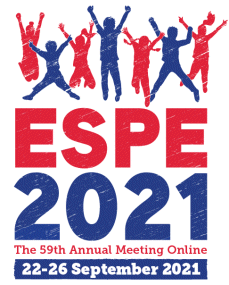
59th Annual ESPE (ESPE 2021 Online)
Online,
22 Sep 2021 - 26 Sep 2021

ePoster Category 2
Growth hormone and IGFs
hrp0094p2-246 | Growth hormone and IGFs | ESPE2021
Massive Open Online Learning – accelerating knowledge in digital health in the management of children with growth disorders
Dimitri Paul , Fernandez-Luque Luis , Koledova Ekaterina , Bagha Merat , Shabbir Syed Abdul ,
hrp0094p2-247 | Growth hormone and IGFs | ESPE2021
A girl with concurrent congenital adrenal hyperplasia, isolated growth hormone deficiency type II (IGHD II) and a new mutation in the GH 1 gene – an extremely unusual case
Genthner N , Blum W , Kamrath C , Wudy SA ,
hrp0094p2-248 | Growth hormone and IGFs | ESPE2021
Reduction in pappalysin and stanniocalcin levels explain the decrease in IGF-I bioavailability in anorexia nervosa
Martin-Rivada Alvaro , Guerra-Cantera Santiago , Campillo-Calatayud Ana , Camarneiro Ricardo , Graell Montserrat , Barrios Vicente , Argente Jesus ,
hrp0094p2-249 | Growth hormone and IGFs | ESPE2021
Predictors of short stature in premature infants born small for gestational age
Yuditskiy Anton , Kovalenko Tatyana , Petrova Irina ,
hrp0094p2-250 | Growth hormone and IGFs | ESPE2021
Patterns of suboptimal adherence to growth hormone treatment in children living in Italy
Centonze Chiara , van Dommelen Paula , Tornicasa Vincenzo , Koledova Ekaterina , Loche Sandro ,
hrp0094p2-251 | Growth hormone and IGFs | ESPE2021
Screening of celiac disease among children with growth hormone deficiency and idiopathic short stature
El-Hawary Amany , Salem Nanees , Abdel Twab Hossam , Badrous Evan ,
hrp0094p2-252 | Growth hormone and IGFs | ESPE2021
Pappalysins and stanniocalcins in prenatal and postnatal life
Martin-Rivada Alvaro , Campillo-Calatayud Ana , Guerra-Cantera Santiago , Sanchez-Holgado Maria , Angel Martos-Moreno Gabriel , Soriano-Guillen Leandro , Pellicer Adelina , Barrios Vicente , Argente Jesus ,
hrp0094p2-253 | Growth hormone and IGFs | ESPE2021
GROWPATI Study: Growth and puberty description pattern in a well-characterized cohort of patients with growth retardation due to severe primary IGF1 deficiency
Stoupa Athanasia , Flechtner Isabelle , Viaud Magali , Pinto Graziella , Samara-Boustani Dinane , Thalassinos Caroline , Netchine Irene , Brioude Frederic , Amselem Serge , Legendre Marie , Polak Michel ,
hrp0094p2-254 | Growth hormone and IGFs | ESPE2021
Clinic, laboratory and prognostic findings of patients who are diagnosed by Kowarski syndrome (biologically inactive growth hormone)
Gokcehan Zevker Emine , Keskin Mehmet , Karaoglan Murat , Aytac Kaplan Emel H ,
hrp0094p2-255 | Growth hormone and IGFs | ESPE2021
Prevalence of insulin-like growth factor 1 (IGF1) deficiency in prepubertal children with isolated short stature (ISS) and their response to GH therapy.
Elsiddig Sohair , Soliman Ashraf , Khalil Ahmed , Alaaraj Nada , Ahmed Hannah ,
hrp0094p2-256 | Growth hormone and IGFs | ESPE2021
Thyroid function (TF) in short children with idiopathic short stature (ISS) treated with growth hormone (GH)versus those not treated; a controlled study.
Elsiddig Sohair , Soliman Ashraf , Alaaraj Nada , Khalil Ahmed , Ahmed Hannah ,
hrp0094p2-257 | Growth hormone and IGFs | ESPE2021
Investigating the impact of the TuiTek patient support programme, designed to support caregivers of children prescribed recombinant human growth hormone treatment for growth hormone deficiency in Taiwan: A pilot study
Su Pen-Hua , Lin Yen-Fan , Jheeta Amrit , Su Su-Huei , Koledova Ekaterina , Graham Selina ,
hrp0094p2-258 | Growth hormone and IGFs | ESPE2021
Incidence of ALS deficiency in patients with growth hormone deficiency at tertiary pediatric endocrinology center
Rankova Kamelia , Iotova Violeta , Bocheva Yana , Shefket Sevim , Yordanova Nikolinka , Bazdarska Yuliya , Tsochev Kaloyan , Galcheva Sonya , Boyadzhiev Veselin ,
hrp0094p2-259 | Growth hormone and IGFs | ESPE2021
Presentation of IGF-1/IGFBP-3 molar ratio as an effective monitoring index during treatment of growth hormone deficient patients
Rankova Kamelia , Iotova Violeta , Bocheva Yana , Shefket Sevim , Boyadzhiev Veselin , Yordanova Nikolinka , Bazdarska Yuliya , Tsochev Kaloyan , Galcheva Sonya ,
hrp0094p2-260 | Growth hormone and IGFs | ESPE2021
Current growth hormone therapy practices in Belgium for the treatment of short children born small for gestational age
Thomas Muriel , Casteels Kristina , Rochtus Anne , van der Straaten Saskia , Van Aken Sara) , Fudvoye Julie , Boros Emese , Dotremont Hilde , Vanbesien Jesse , Mouraux Thierry , Chivu Olimpia , Logghe Karl , Reynaert Nele , Massa Guy , Depoorter Sylvia , Klink Daniel , Becker Marianne , Lysy Philippe , De Schepper Jean ,
hrp0094p2-261 | Growth hormone and IGFs | ESPE2021
Increased height and IGF1 serum levels in children with non-neurofibromatosis type 1 gliomas
Clement Florencia , Castro Sebastian , Dech Gaston , Martin Ayelen , Celia Fernandez Maria , Gabriela Ropelato Maria , Bergada Ignacio , Gabriela Ballerini Maria , Pennisi Patricia ,
hrp0094p2-262 | Growth hormone and IGFs | ESPE2021
A Survey on Clinician Perceptions of Long-Acting Growth Hormone Analogs
Howard-James Naomi , Padidela Raja , Raimann Adalbert , Gevers Evelien , Semler Oliver , McDonnell Ciara ,
hrp0094p2-263 | Growth hormone and IGFs | ESPE2021
Pituitary gland volume measured by Magnetic Resonance Imaging as diagnostic predictor of persistent Childhood-onset growth hormone deficiency
Corredor-Andres Beatriz , Walton-Betancourth Sandra , Brain Caroline , Butler Gary , Hindmarsh Peter , Dattani Mehul ,
hrp0094p2-264 | Growth hormone and IGFs | ESPE2021
Growth hormone (GH) treatment of children with idiopathic short children (ISS) with normal insulin-like growth factor-1 (IGF-1) versus those with low IGF-I at diagnosis.
Elsiddig Sohair , Soliman Ashraf , Alaaraj Nada , Khalil Ahmed , Ahmed Hannah ,
hrp0094p2-265 | Growth hormone and IGFs | ESPE2021
Growth response to growth hormone therapy in growth hormone deficient (GHD) children in relation to the distance between their height SDS (HtSDS) and their mid-parental height.
Elsiddig Sohair , Soliman Ashraf , Alaaraj Nada , Khalil Ahmed , Ahmed Hannah ,
hrp0094p2-266 | Growth hormone and IGFs | ESPE2021
Linear growth and response to GH therapy in children with short stature with normal Growth hormone secretion: Comparison between children with delayed versus no delay in the bone age at diagnosis.
Elsiddig Sohair , Soliman Ashraf , Alaaraj Nada , khalil Ahmed , Ahmed Hannah ,
hrp0094p2-267 | Growth hormone and IGFs | ESPE2021
Linear growth and response to GH therapy in children with GHD with normal IGF-I versus those with normal GH secretion associated with low IGFI at presentation.
Elsiddig Sohair , Soliman Ashraf , Khalil Ahmed , Alaaraj Nada , Ahmed Hannah ,
hrp0094p2-268 | Growth hormone and IGFs | ESPE2021
Growth response to growth hormone therapy in short children in relation to their distance from mid-parental heights (MPHt).
Elsiddig Sohair , Soliman Ashraf , Alaaraj Nada , Khalil Ahmed , Ahmed Hannah ,
hrp0094p2-269 | Growth hormone and IGFs | ESPE2021
Immunogenicity of recombinant growth hormone therapy in the children with short stature and consequences on growth-promoting effect
Karaoglan Murat , Isbilen Elif , Keskin Mehmet ,
hrp0094p2-270 | Growth hormone and IGFs | ESPE2021
Unified training materials to improve adherence to GH-treatment
Lundberg Elena , Renholm Petra , Molin AEsa , Ellerth Ebba , Ernstsson Camilla ,
hrp0094p2-271 | Growth hormone and IGFs | ESPE2021
Linear growth of prepubertal children born small for gestational age on growth hormone therapy for 3 years
Al Shaikh Adnan , Daftardar Hadeer , Aziz Alghamdi Abdul , Jamjoom Majd , Awidah Saniah , Ahmed Mohamed E , Soliman Ashraf ,
hrp0094p2-272 | Growth hormone and IGFs | ESPE2021
Evaluation of the clinical and laboratory parameters and final adult height in patients treated with recombinant human growth hormone.
Sayin Emine , Altincik Ayca , Ozhan Bayram ,
hrp0094p2-273 | Growth hormone and IGFs | ESPE2021
The results of treatment with growth hormone in a patient with growth hormone deficiency and type 1 diabetes
Rakus-Kwiatosz Anna , Banecka Bozena , Ben-Skowronek Iwona ,
hrp0094p2-274 | Growth hormone and IGFs | ESPE2021
Aetiology and different clinical conditions of GHD in children in a region of North Africa
Fadila Bouferoua , Hamza Boucenna , Nabila Bouterfas , Lynda Sekfali , Aida Mohandoussaid , Nafissa Benhalla ,
hrp0094p2-275 | Growth hormone and IGFs | ESPE2021
Growth hormone therapy in short stature: The variability of responses to treatment after one year. About 41 cases
El Yamani Nada , Abdellaoui Wahiba , Benyakhlef Salma , Rouf Siham , Latrech Hanane ,
hrp0094p2-276 | Growth hormone and IGFs | ESPE2021



